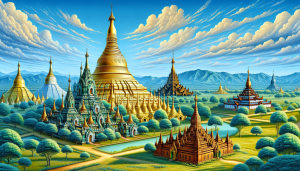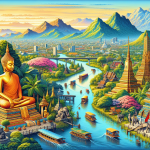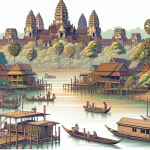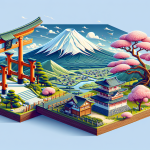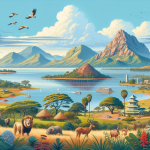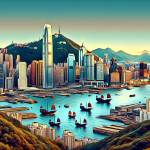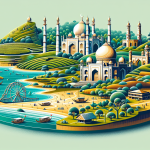Discovering the Hidden Gems of Myanmar (Burma)
Myanmar, formerly known as Burma, is a Southeast Asian country that has only recently opened its doors to tourism on a significant scale. This enchanting land boasts a rich tapestry of culture, history, and natural beauty that beckons travelers from around the globe. With its golden pagodas, ancient temples, lush landscapes, and vibrant local markets, Myanmar offers an array of experiences that captivate the hearts of many. This guide is designed to help you explore the hidden gems of Myanmar, whether you’re a history buff, an adventure seeker, or someone simply looking to immerse yourself in a new culture. From the bustling streets of Yangon to the tranquil shores of Inle Lake, Myanmar promises an unforgettable journey. So, pack your bags and get ready to uncover the wonders of Myanmar (Burma)!
Yangon: The Gateway to Myanmar
The Shwedagon Pagoda
The Shwedagon Pagoda in Yangon stands as one of Myanmar’s most iconic landmarks. This gilded stupa, towering at 99 meters, is said to enshrine strands of Buddha’s hair. As you walk around the complex, you’ll be mesmerized by the shimmering golden surface, especially during sunset. The atmosphere is both spiritual and awe-inspiring, with locals and tourists alike offering their prayers and paying their respects.
Bogyoke Aung San Market
For an authentic local experience, head to the Bogyoke Aung San Market. This bustling market is a treasure trove of traditional crafts, jewelry, and textiles. It’s the perfect place to pick up souvenirs and immerse yourself in the local culture. Don’t forget to haggle a bit; it’s part of the fun!
Kandawgyi Lake
Kandawgyi Lake offers a serene escape from the hustle and bustle of Yangon. The lake is surrounded by lush gardens and features a boardwalk that provides stunning views of the Shwedagon Pagoda. It’s an ideal spot for a leisurely stroll or a peaceful afternoon picnic.
Bagan: The Land of Temples
Ananda Temple
One cannot visit Myanmar without exploring the ancient city of Bagan, home to over 2,000 temples and pagodas. Among these, the Ananda Temple stands out for its architectural beauty and spiritual significance. Built in 1105 AD, this temple is considered a masterpiece of Mon architecture. The interior features four towering Buddha statues, each facing a cardinal direction, symbolizing the spread of Buddhism.
Hot Air Balloon Ride
For a truly unforgettable experience, take a hot air balloon ride over Bagan. As you float above the ancient landscape, you’ll witness a panoramic view of temples, pagodas, and the Ayeyarwady River. The sight of the sun rising over this historical landscape is nothing short of magical.
Mount Popa
A short drive from Bagan, Mount Popa is a volcanic mountain that rises 1,518 meters above sea level. It’s home to the Popa Taungkalat Shrine, a sacred site perched atop a sheer cliff. The climb to the top involves ascending 777 steps, but the breathtaking views and the spiritual ambiance make it well worth the effort.
Inle Lake: Serenity and Culture
Floating Gardens
Inle Lake is renowned for its unique floating gardens, where local farmers grow tomatoes, cucumbers, and other vegetables on beds of water hyacinths. These gardens are anchored to the lakebed with bamboo poles, creating a fascinating agricultural system. Exploring the lake by boat allows you to witness this ingenious method of farming up close.
Phaung Daw Oo Pagoda
The Phaung Daw Oo Pagoda is one of Inle Lake’s most revered religious sites. This pagoda houses five ancient Buddha images, which are so heavily gilded with gold leaf that their original forms are almost unrecognizable. The pagoda also hosts an annual festival that features boat races and other traditional celebrations.
Indein Village
For a glimpse into the local way of life, visit Indein Village. This charming village is famous for its crumbling pagodas and traditional wooden houses. The Indein Pagoda complex, with its hundreds of ancient stupas, offers a sense of mystery and history. As you wander through the village, you’ll encounter friendly locals who are happy to share their stories and traditions.
Mandalay: The Cultural Capital
Mandalay Palace
Mandalay Palace is the last royal palace of the Burmese monarchy. Although much of the original structure was destroyed during World War II, the palace has been meticulously reconstructed. The sprawling complex includes numerous pavilions, chambers, and gardens, offering a glimpse into the grandeur of Myanmar’s royal past.
U Bein Bridge
Stretching 1.2 kilometers across Taungthaman Lake, the U Bein Bridge is the world’s longest teakwood bridge. This iconic structure, built in the 1850s, is a popular spot for both locals and tourists. Walking across the bridge at sunset provides a picturesque view and an opportunity to interact with the friendly locals.
Kuthodaw Pagoda
Known as the “World’s Largest Book,” the Kuthodaw Pagoda features 729 marble slabs inscribed with Buddhist teachings. Each slab is housed in its own stupa, creating a mesmerizing sight. This unique pagoda is a testament to Myanmar’s deep-rooted Buddhist heritage and offers a peaceful retreat from the city’s hustle and bustle.
Ngapali Beach: A Tropical Paradise
Pristine Beaches
Ngapali Beach is Myanmar’s premier beach destination, known for its pristine white sands and crystal-clear waters. The beach stretches for several kilometers, providing ample space for relaxation and water activities. Whether you prefer lounging under a palm tree or swimming in the warm waters, Ngapali Beach offers a perfect tropical getaway.
Local Seafood
Ngapali Beach is also renowned for its fresh seafood. Local fishermen bring in their catch daily, ensuring a delightful culinary experience for visitors. Enjoy a seafood feast at one of the beachfront restaurants, where you can savor dishes like grilled fish, prawns, and crab while taking in the stunning ocean views.
Adventure Activities
For those seeking adventure, Ngapali Beach offers a range of activities, including snorkeling, kayaking, and cycling. Explore the vibrant underwater world, paddle through mangrove forests, or cycle along the scenic coastline. There’s something for everyone at this idyllic beach destination.
Hpa-An: A Journey Through Nature
Sadan Cave
Sadan Cave is one of Hpa-An’s most impressive natural attractions. This massive limestone cave features stunning stalactites and stalagmites, as well as a serene underground lake. A boat ride through the cave leads to a hidden lake surrounded by lush greenery, creating a magical experience.
Mount Zwegabin
For a challenging yet rewarding hike, ascend Mount Zwegabin. The trek to the summit takes approximately two to three hours and offers panoramic views of the surrounding countryside. At the top, you’ll find a monastery and a giant Buddha statue, providing a tranquil setting for reflection.
Kyauk Ka Lat Pagoda
Perched on a limestone pinnacle in the middle of a lake, the Kyauk Ka Lat Pagoda is a unique and picturesque site. The pagoda offers stunning views of the surrounding landscapes, including Mount Zwegabin. It’s a peaceful spot for meditation and contemplation, away from the hustle and bustle of everyday life.
Mrauk U: The Ancient Kingdom
Shite-Thaung Temple
Shite-Thaung Temple, also known as the Temple of 80,000 Buddhas, is one of Mrauk U’s most significant historical sites. This temple, built in 1535, features intricate carvings and numerous Buddha statues. The labyrinthine corridors and chambers create a sense of mystery and wonder.
Koethaung Temple
As the largest temple in Mrauk U, Koethaung Temple is a must-visit for history enthusiasts. The temple’s name translates to “Temple of 90,000 Buddha Images,” and it lives up to its name with its vast collection of statues and carvings. Exploring this ancient site offers a glimpse into the rich cultural heritage of the Rakhine Kingdom.
Mrauk U Archaeological Museum
To gain a deeper understanding of Mrauk U’s history, visit the Mrauk U Archaeological Museum. The museum houses a collection of artifacts, sculptures, and relics that provide insight into the region’s past. It’s an excellent place to learn about the ancient kingdom and its cultural significance.
Practical Tips for Traveling in Myanmar
Best Time to Visit
The best time to visit Myanmar is during the cool season, from November to February. During this period, the weather is pleasant, with lower temperatures and less humidity. It’s ideal for exploring the country’s many outdoor attractions.
Visa Requirements
Most travelers will need a visa to enter Myanmar. You can apply for an e-visa online, which is a convenient option for most tourists. Ensure your passport is valid for at least six months from your date of entry.
Local Currency
The official currency of Myanmar is the Kyat (MMK). While major cities and tourist areas have ATMs and currency exchange services, it’s advisable to carry cash, especially when visiting remote regions. Credit cards are not widely accepted, so having sufficient local currency is essential.
Respect Local Customs
Myanmar is a country with deep-rooted traditions and customs. When visiting religious sites, dress modestly and remove your shoes before entering. It’s also important to respect local customs and traditions, such as greeting people with a slight bow and using both hands when giving or receiving items.
Conclusion
Myanmar (Burma) is a country of incredible diversity, offering a blend of rich history, vibrant culture, and stunning natural beauty. From the ancient temples of Bagan to the tranquil shores of Inle Lake, there’s something for everyone to enjoy. As you explore this captivating destination, you’ll discover not only its well-known attractions but also its hidden gems. Whether you’re a first-time visitor or a seasoned traveler, Myanmar promises a journey of discovery and wonder. So, embark on an adventure to Myanmar and uncover the treasures that await you in this enchanting land.
For more detailed guides and travel tips, visit Travel Blog.
